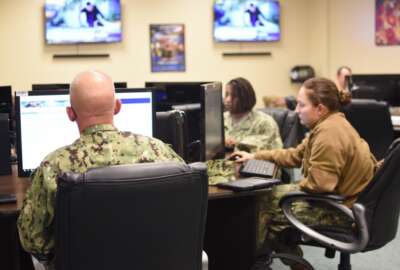
Army issues solicitation to commercialize IT on its installations
Responses to the Army's Enterprise IT-as-a-Service prototype are due within a month, work is set to begin by the end of this year.
The Army is kicking off a rapid acquisition process for a pilot project that could eventually wind up commercializing the IT networks on its more than 200 bases around the world.
Assuming the pilots are successful, it’s likely to be several more years before the vendor-managed technology is fully up and running on each installation. But officials strongly suspect the modernization process would take even longer if the Army continued to own and operate its own networks — a paradigm the other military services have already moved away from.
The Enterprise IT-as-a-Service (EITaaS) pilot aims to start with up to nine bases over the next year, and the Army is in a hurry to start proving the concept out. Using other transaction agreements (OTAs) instead of traditional contracts, it’s planning to hire up to three different vendors to begin work by the end of this fiscal year; each will be asked to install contractor-operated networks on a small, medium and large-sized base. Responses to the prototype announcement the Army released last week are due back from industry in less than a month.
Dan Joyce, the assistant program executive officer for cyber, networks and services in the Army Program Executive Office for Enterprise Information Systems said speed and the ability to have more freewheeling exchanges with industry are what made OTAs an attractive option for EITaaS.
Related Stories

Pentagon prevails in legal challenge to its JEDI Cloud contract
Joyce said the OTA route also let vendors provide more ongoing input about what’s feasible in the commercial IT sector than would have been possible in the formal, written Q&As and requests for information that usually accompany a traditional procurement.
“We had some preconceived notions about requirements. For example, we had a thought that maybe we have to be really focused on regions,” he said. “But industry told us that’s really not a big issue for us, so that allowed us to quickly change our requirement. From our first sessions in December to our final solicitation last Tuesday, that’s just, just a little over seven months. That’s phenomenal to get something done that quickly.”
But officials say they don’t have many preconceived notions about precisely which services vendors will provide in the EITaaS construct or how much control the government will retain over Army networks.
The Navy and Marine Corps were the first military services to outsource their enterprise IT via the Navy-Marine Corps Intranet in the early 2000s, and the Air Force followed with a similar EITaaS project beginning last year. Army officials say they’ve been asking a lot of questions of both services about how things have worked, but haven’t reached any firm conclusions yet about how much control to turn over to contractors.
“It’s important that we’re not specifying one desired product, one desired level of performance, because we’re aware that there’s a diversity of product performance out there for commercial buyers of large-scale IT,” said Charlie Stadtlander, the communications director at Army Cyber Command. “We’re going to push the envelope and demand a high quality of service, but without getting too much into the technical specifics. We think the diversity of multiple vendors allows us to conduct a true pilot, really see what’s out there, what different vendors might be able to offer and just see what’s going to work best for the Army.”
The first three sites the Army picked for the pilot — each of which should start seeing at least some planning activities by the end of this year — are Army Futures Command in Austin, Texas, Fort Polk in Louisiana, and Camp Roberts in California.
During the pilot, the Army is asking contractors to install “non-interfering” networks and services alongside the existing government-owned infrastructure.
“For the end user, the goal is to not have a visible disruption to your day to day business, and ideally an improvement in the speed, connectivity, lower down times, quicker help desk service, et cetera,” Stadtlander said. “The goal is not to produce a shadow IT system that disrupts what’s going on today. I think a lot of the change will happen behind the scenes with a lot of the existing equipment that’s there today.”
If the Army is happy with the outcome of the pilot projects, it has the option of granting the firms who conduct the pilots additional follow-on production OTAs. But no decision has been made about the contracting approach the service will eventually use to conduct larger-scale IT modernization work, Joyce said.
“If the vendor’s doing a great job, we’re getting a better quality product for the amount of money we’ve been investing in the past, and Army senior leaders say we’d like to continue that effort, we have that option to go to production,” he said. “But my personal opinion — and this is not Army policy — is I don’t see us doing 288 camps, post and stations all out of an OTA. In my time in acquisition, one of my recurring favorite phrases is ‘Congress gets a vote.’ And I’m sure we would probably have some issues with the Congress about wanting to see more competition if we tried to do that.”
Copyright © 2024 Federal News Network. All rights reserved. This website is not intended for users located within the European Economic Area.
Jared Serbu is deputy editor of Federal News Network and reports on the Defense Department’s contracting, legislative, workforce and IT issues.
Follow @jserbuWFED




